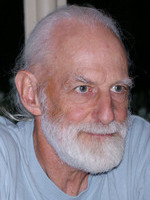Ian Maddieson
Adjunct Research Professor (1942-2025)

(b. September 1, 1942 - d. February 2, 2025)
Ian Maddieson was born in Watford, London and grew up in Lydd on the Kent coast. After graduating from Oxford, Ian spent a year volunteering overseas teaching English and French in Ghana. Ian started the graduate program in Linguistics at the School of Oriental and African Studies. After receiving his Master’s, he was a tutor at Oxford and then Lecturer at the University of Ibadan, Nigeria from 1968-1971. Ian was invited to teach at Indiana University for a year and then to do research with Vicki Fromkin and Peter Ladefoged at UCLA. Ian’s winding path to a PhD ended at UCLA in 1977. From then on, Ian was able to make a career as a research linguist funded by a succession of grants, holding positions at UCLA and UC Berkeley, retiring in 2006. In 2004 Ian and Caroline Smith, phonetician and laboratory phonologist at the University of New Mexico, were married. Ian moved to New Mexico in 2006 where he was Adjunct Research Professor at the University of New Mexico.
Ian was primarily known for his work in phonological typology. He established the first world-wide database of phonemic inventories in the early 1980s, the UCLA Phonological Segment Inventory Database (UPSID). The database continued to be expanded over the years. The latest version was created while Ian was conducting research at the Laboratoire Dynamique du Langage, a CNRS-funded research center at the Université Lyon-2. The result was the Lyon-Albuquerque Phonological Systems Database (LAPSyD), covering 764 languages and including data on segmental inventories, syllable structures, stress, and tonal systems.
Ian drew on his phonological databases to uncover universals of phonology. This work actually began at the Language Universals Project under Joseph Greenberg and Charles Ferguson at Stanford in 1975, from which Ian published research on the universals of tone systems. In 1984 he published Patterns of sounds, which was re-issued in 2009. Patterns of sounds presents a large number of universals of phonological segments, as well as publishing the contents of UPSID at the time. Later, Ian contributed 12 chapters to the World Atlas of Language Structures (WALS), a widely-used resource for the study of typological patterns. He also played leadership roles in the International Phonetic Association, where he served as Vice President and as Editor of the Journal, and the Association for Laboratory Phonology, where he served as Secretary. His honors included being elected a Fellow of the American Academy for the Advancement of Science in 2013.
In addition to research on phonetics and phonological typology, Ian explored other topics of theoretical interest, including language complexity, language evolution and language-environment interactions. Ian demonstrated that the widely-held belief that greater complexity in one part of the phonological system is compensated by greater simplicity in another part does not hold for the phonological complexity measures that he examined based on LAPSyD data. Working with primatologists, Ian suggested that an important factor in the evolution of human speech may be the emergence of consonant distinctions with the evolution of advanced supralaryngeal control. Ian and complex systems colleagues at the Santa Fe Institute questioned a hypothesis that the geographical distribution of phonological diversity was a trace of out-of-Africa human migration. Instead, Ian suggested that phonological diversity data supports a variant of the Acoustic Adaptation Hypothesis in which sonority of segments in language use is correlated to mean annual temperature in the area where the language is spoken. Ian’s most recent research critically examined widely-held beliefs in phonological typology. In one project, he explored how dominant languages of recent imperial expansions tend to distort ideas of what patterns are typical in phonetic and phonological systems, and in another, he demonstrated through a systematic synchronic and diachronic study that tonal systems are not as predominant or historically original as they are frequently claimed to be.
Ian worked closely with Peter Ladefoged from the 1970s until Peter’s death in 2006. Their collaboration produced many papers on phonetics and culminated in the seminal publication The sounds of the world’s languages in 1996. In addition to research in the lab, Ian and Peter traveled the world in search of unusual or little-known speech sounds. Ian often took advantage of these travels to engage in his other great passion, running long distances, participating in races during fieldwork trips in locations as diverse as Taiwan, Kenya and Argentina. In the 1980s and 1990s, he focused his running on the Western States 100 mile Endurance Run. His 15 finishes at Western States (with 10 under 24 hours) were his proudest accomplishments, even compared to the 34 other 100-mile races that he completed or his many finishes in ultramarathons of other distances. He completed 100 miles in a multi-day race only a month before his death, thus achieving his life-long goal of forever being a 100-mile runner. He applied the same dedication, persistence, and attention to detail to running and to linguistics, with exceptional achievements in both domains. Even more important was the kindness and humanity he demonstrated as a colleague, a teacher, a running mate and a mentor to the many who were changed by knowing him.
